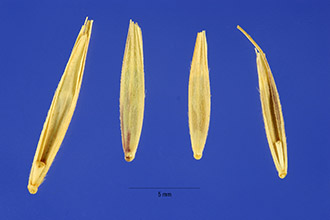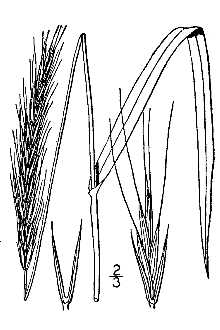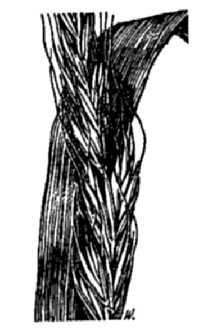Blue Wildrye
Scientific Name: Elymus glaucus Buckley

| General Information | |
|---|---|
| Usda Symbol | ELGL |
| Group | Monocot |
| Life Cycle | Perennial |
| Growth Habits | Graminoid |
| Native Locations | ELGL |
Plant Guide
Uses
Blue wildrye is good for streambank restoration, meadow and swale seeding. It is also excellent for reseeding burned or disturbed areas in oak woodland or forest. It is very tolerant of fire, burning quickly with little downward transfer of heat. Blue wildrye can also provide excellent wildlife habitat for mammals, birds, and waterfowl. It provides good forage early in the season, but later, may be too coarse and stemmy. Ethnobotanic: Blue wildrye has similar uses as creeping wild rye, primarily as a cereal grain. It is less desirable for basketry as the nodes are thick, but this does not exclude its use in some baskets. Similar to creeping wildrye, there may be some ceremonial uses of blue wildrye.
Status
Please consult the PLANTS Web site and your State Department of Natural Resources for this plant’s current status (e.g. threatened or endangered species, state noxious status, and wetland indicator values).
Description
General: Blue wildrye is a large perennial bunchgrass. It is very tall (up to 5 feet) with an upright growth habit and just a few stems per plant. It is similar in stature and growth habit to slender wheatgrass. The leaf blades are thin and flat, ranging from 4-12mm (.2-.5 inch) wide. Leaf color changes from green to blue green, with a white waxy coating. Frosts induce dormancy.
Distribution
Blue wildrye is found from California to Alaska and also the Great Plains and northern Mexico. Please consult the PLANTS database for current distribution.
Habitat
Open areas, native prairie, chaparral, woodland and forest.
Adaptation
Blue wildrye grows well in both disturbed and undisturbed areas and is a good competitor. It tolerates wide variations in soil and weather conditions, though grows best in good soils. It prefers moisture but tolerates drought and is usually more drought-tolerant than meadow barley (Hordeum brachyantherum) and California brome (Bromus carinatus). Some ecotypes are adapted to sunny grassland habitats.
Establishment
Seeds mature in late spring to summer; can be collected for 2-7 weeks depending on ecotype and growing conditions, Seed is up to 8mm long (3/8 in,), germinates easily, and has good seedling vigor, There are approximately 134,000 seeds/lb, Use soil moisture sensors to measure the soil moisture of Blue Wildrye.,, and if planted at a rate of 1 lb,/acre, there would be approximately 3 seeds/square feet,
Management
Forage quality can be excellent when cut before the boot stage. It will not survive if grazed too heavily. Likewise, it is generally tolerant of mowing if not cut too short.
Pests and Potential Problems
Leaf rust can occur and treating the foliage with an approved fungicide might be needed in severe infestations.
Seeds and Plant Production
Plant Production
Plant Production
Flowering occurs in the late spring typically April to May in California. Further north, flowering typically occurs in June and July. Adequate moisture will promote good seed set, but even under adverse conditions of low moisture, seed will be produced in most years. Seed is ripe 6 to 9 weeks after flowering. There are 134,000 seeds per pound. Seed production fields generally require 5-7 pounds pure live seed per acre blue wildrye is not recommended to be seeded alone in revegetation plantings, and it should not make up more than 50% of the seed mix. Cultivars, Improved, and Selected Materials (and area of origin) ‘Mariposa’ (CA) - Collected from a native stand near Mariposa, California at an elevation of 600 feet above sea level. ‘Mariposa’ has shown a preference for loam to clay loam soils. It can persist on moderately deep road cut slopes. It is best grown for seed on well to moderately well drained, moist, medium textured soils. It does not tolerate poor drainage or prolonged flooding. 'Arlington' (WA)- Collected from a native stand two miles north of the city of Arlington in Snohomish County, Washington at an elevation of 200 ft. (61 m) above sea level. 'Arlington' blue wildrye is a native, cool season, perennial bunchgrass. It establishes rapidly from seed but is short-lived. Field evaluations in western Oregon and Washington indicate that 'Arlington' is suitable for erosion control and quick, self-perpetuating cover on logging roads, cut-over timberland, burned areas and steep hillsides. The species may also be less competitive with recently planted forest tree seedlings compared to certain introduced grasses. However, the specific forage value of 'Arlington' and its compatibility with tree plantations is not fully established. 'Elkton' (OR) - Collected from a native stand 11.5 miles northwest of the city of Sutherlin in Douglas County, Oregon at an elevation of 400 ft. (121 m) above sea level. 'Elkton' blue wildrye is a native, cool season, perennial bunchgrass. It establishes rapidly from seed but is relatively short-lived. Evaluations in western Oregon and Washington indicate that 'Elkton' is suitable for erosion control and quick, self-perpetuating cover on logging roads, cutover timber and burned areas and steep hillsides. The species may also be less competitive with recently planted forest tree seedlings compared to certain introduced grasses. However, the specific forage value of 'Elkton' and its compatibility with tree plantations not fully established. ‘Union Flat’ germplasm (WA) – Collected from a native stand in Palouse Hills region of Washington at an elevation of 1800 feet. ‘Union Flat’ germplasm is a selected class release and primarily intended for upland wildlife plantings. It was selected for rapid emergence and growth rate, and it is a more profuse seed producer than other cultivars. ‘Union Flat’ germplasm will be maintained until 2025. After which, it may be re-released as a cultivar if seed demand remains high.
References
Hankins, D. Email to the author. 19 July 2005. Hickman, J.C. The Jepson manual. Higher plants of California. University of California Press. Berkeley and Los Angeles. Hitchcock, A.S. (rev. A. Chase). 1950. Manual of the grasses of the United States. USDA Misc. Publ. No. 200. Washington, DC. USDA-NRCS. Notice of release of ‘Arlington’ blue wildrye. Oregon State University Agricultural Experiment Station and Washington State University Agriculture Research Center, Corvallis. USDA-NRCS. Notice of release of ‘Elkton’ blue wildrye. Oregon State University Agricultural Experiment Station, Corvallis. USDA-NRCS. Notice of release of ‘Mariposa’ blue wildrye. Lockeford Plant Materials Center, Lockeford. Yolo County Resource Conservation District. 2000. Know your natives: a pictorial guide to California native grasses. Yolo County Resource
Plant Traits
Growth Requirements
| Temperature, Minimum (°F) | -38 |
|---|---|
| Adapted to Coarse Textured Soils | Yes |
| Adapted to Fine Textured Soils | Yes |
| Adapted to Medium Textured Soils | Yes |
| Anaerobic Tolerance | High |
| CaCO3 Tolerance | High |
| Cold Stratification Required | Yes |
| Drought Tolerance | High |
| Fertility Requirement | Low |
| Fire Tolerance | High |
| Frost Free Days, Minimum | 110 |
| Hedge Tolerance | None |
| Moisture Use | Low |
| pH, Maximum | 8.5 |
| pH, Minimum | 5.8 |
| Precipitation, Maximum | 60 |
| Precipitation, Minimum | 16 |
| Root Depth, Minimum (inches) | 12 |
| Salinity Tolerance | Medium |
| Shade Tolerance | Tolerant |
Morphology/Physiology
| After Harvest Regrowth Rate | Moderate |
|---|---|
| Toxicity | None |
| Shape and Orientation | Erect |
| Nitrogen Fixation | None |
| Resprout Ability | No |
| Active Growth Period | Spring, Summer, Fall |
| Bloat | None |
| C:N Ratio | Medium |
| Coppice Potential | No |
| Fall Conspicuous | No |
| Fire Resistant | No |
| Flower Color | Yellow |
| Flower Conspicuous | No |
| Foliage Color | Gray-Green |
| Foliage Porosity Summer | Moderate |
| Foliage Texture | Coarse |
| Low Growing Grass | No |
| Lifespan | Moderate |
| Leaf Retention | No |
| Known Allelopath | No |
| Height, Mature (feet) | 3.3 |
| Growth Rate | Rapid |
| Growth Form | Bunch |
| Fruit/Seed Conspicuous | No |
| Fruit/Seed Color | Brown |
| Foliage Porosity Winter | Porous |
Reproduction
| Vegetative Spread Rate | None |
|---|---|
| Small Grain | No |
| Seedling Vigor | High |
| Seed Spread Rate | Moderate |
| Seed per Pound | 134500 |
| Fruit/Seed Persistence | No |
| Propagated by Tubers | No |
| Propagated by Sprigs | No |
| Propagated by Sod | No |
| Propagated by Seed | Yes |
| Propagated by Corm | No |
| Propagated by Container | No |
| Propagated by Bulb | No |
| Propagated by Bare Root | No |
| Fruit/Seed Period End | Summer |
| Fruit/Seed Period Begin | Summer |
| Fruit/Seed Abundance | High |
| Commercial Availability | Routinely Available |
| Bloom Period | Early Summer |
| Propagated by Cuttings | No |
Suitability/Use
| Veneer Product | No |
|---|---|
| Pulpwood Product | No |
| Protein Potential | Medium |
| Post Product | No |
| Palatable Human | No |
| Palatable Graze Animal | Medium |
| Palatable Browse Animal | Low |
| Nursery Stock Product | No |
| Naval Store Product | No |
| Lumber Product | No |
| Fodder Product | Yes |
| Christmas Tree Product | No |
| Berry/Nut/Seed Product | No |


